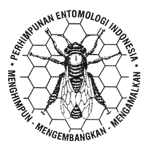Pengujian Ekstrak Tumbuhan Vitex trifolia L., Acorus colomus L., dan Andropogon nardus L. terhadap Hama Pasca Panen Araecerus fasciculatus De Geer (Coleoptera: Anthribidae) pada Biji Kakao
DOI:
https://doi.org/10.5994/jei.7.1.1Keywords:
Araecerus fasciculatus, Vitex trifolia, Acorus colomus, Andropogon nardus, cocoa, repellant, attractantAbstract
Araecerus fasciculatus (Coleoptera: Anthribidae) is a primary pest mostly found in cocoa bean storage. Controlling A. fascuculatus is highly necessary, as this action would also reduce infestation of secondary pests. Utilization of natural materials as bait or trap is one applicable method to lessen damage and loss during storage. Vitex trifolia L., Acorus colomus L., and Andropogon nardus L are plant species that posess insecticidal properties that can be used to control post harvest pests. Materials used in this experiment are leaves of V. trifolia, rhizome of A. colomus and leaves of A. nardus. The three types of materials are blended and sieved with 300 mesh until finely broken up for make powder formulation. As much as 1 g of powder extract was taken then mixed with additional substract (water + CMC + saw dusts). The mixtures were then shaped in the form of ellipse resembling cocoa beans with approximately similar weight of 0.6 g (± 20 beans). Results show that V. trifolia and A. nardus are highly repellent (90.5 % and 94.5%) to A. fasciculatus, and crhizome of A. colomus is attractant to A. fasciculatus.Downloads
Download data is not yet available.
Downloads
Published
2015-09-28
How to Cite
SJAM, S., MELINA, M., & THAMRIN, S. (2015). Pengujian Ekstrak Tumbuhan Vitex trifolia L., Acorus colomus L., dan Andropogon nardus L. terhadap Hama Pasca Panen Araecerus fasciculatus De Geer (Coleoptera: Anthribidae) pada Biji Kakao. Jurnal Entomologi Indonesia, 7(1), 1. https://doi.org/10.5994/jei.7.1.1
Issue
Section
Articles
License
Authors who publish with this journal agree to the following terms:
- Authors retain copyright and grant the journal right of first publication with the work simultaneously licensed under a Creative Commons Attribution 4.0 International License that allows others to share the work with an acknowledgement of the work's authorship and initial publication in this journal.
- Authors are able to enter into separate, additional contractual arrangements for the non-exclusive distribution of the journal's published version of the work (e.g., post it to an institutional repository or publish it in a book), with an acknowledgement of its initial publication in this journal.
- Authors are permitted and encouraged to post their work online (e.g., in institutional repositories or on their website) prior to and during the submission process, as it can lead to productive exchanges, as well as earlier and greater citation of published work (See The Effect of Open Access).








